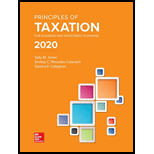
Principles Of Taxation For Business And Investment Planning 2020 Edition
23rd Edition
ISBN: 9781259969546
Author: Sally Jones, Shelley C. Rhoades-Catanach, Sandra R Callaghan
Publisher: McGraw-Hill Education
expand_more
expand_more
format_list_bulleted
Textbook Question
Chapter 14, Problem 4IRP
Mr. Tilton is a 20-year-old college student. This year he lived on campus for nine months and in his parents’ home during the summer. His parents paid for all Mr. Tilton’s living expenses, but a scholarship paid for his $22,000 college tuition.
Expert Solution & Answer
Want to see the full answer?
Check out a sample textbook solution
Students have asked these similar questions
Kindly give a step by step details explaination of each answers especially question 5 and 6. Please, don't just give answers without explaining how we arrived at the answer. Thanks!
The following are the questions:
1. What is the general journal entries the transactions described for Hogan Company. All sales are on account. Use the date of December 31 to make the entry to summarize sales for the year in the old territory and new territory.
2. Make the journal entries to record the write-off of accounts in the new territory.
3. Make the journal entry to record the write-off of accounts in the old territory.
4. Make the entry on December 31 to record uncollectible accounts expense for 20X1 for both territories. Make the calculation using the percentages developed by Hogan.
5. Let’s say the Allowance for Doubtful Accounts had a credit balance of $24,800 on September 30 before any of the above entries were made. Calculate the balance in the allowance account after…
Financial accounting
General Accounting
Chapter 14 Solutions
Principles Of Taxation For Business And Investment Planning 2020 Edition
Ch. 14 - Prob. 1QPDCh. 14 - Prob. 2QPDCh. 14 - Why is the formula for computing individual...Ch. 14 - Discuss possible tax policy reasons why...Ch. 14 - Prob. 5QPDCh. 14 - Identify the reasons why individual taxpayers...Ch. 14 - Prob. 7QPDCh. 14 - Individuals who plan to bunch itemized deductions...Ch. 14 - Prob. 9QPDCh. 14 - Single individuals Sam and Zelle were married this...
Ch. 14 - Prob. 11QPDCh. 14 - Under the current rate structure, a high-income...Ch. 14 - Prob. 13QPDCh. 14 - Prob. 14QPDCh. 14 - Prob. 15QPDCh. 14 - Prob. 16QPDCh. 14 - Determine Ms. Arnouts filing status in each of the...Ch. 14 - Determine Mr. Jenkinss 2019 filing status in each...Ch. 14 - Mr. and Mrs. Keppner file a joint income tax...Ch. 14 - Prob. 4APCh. 14 - Ms. West is an unmarried individual. Determine if...Ch. 14 - Mr. and Mrs. Ohlson file a joint income tax...Ch. 14 - Ms. Gomez earned a 91,250 salary, and Mr. Hill...Ch. 14 - Mr. Olaf earned an 89,000 salary, and Mrs. Olaf...Ch. 14 - Mr. and Mrs. Daku have the following income items....Ch. 14 - Mr. and Mrs. Simpson have the following income...Ch. 14 - Ms. Timmons, an unmarried individual, has the...Ch. 14 - Prob. 12APCh. 14 - Mr. Coleman, an unmarried individual, has the...Ch. 14 - Mr. and Mrs. Ludwig have the following income...Ch. 14 - Mr. Rogers, an unmarried individual, had the...Ch. 14 - Ms. Ellis, a single individual, has 115,000...Ch. 14 - Ms. Barnes, an unmarried individual, has 196,400...Ch. 14 - Prob. 18APCh. 14 - Mr. Garrett, a single taxpayer, has 15,700 AGI....Ch. 14 - Danny Liu is 20 years old and is considered a...Ch. 14 - Mr. and Mrs. Palio celebrated the birth of their...Ch. 14 - Mr. Masons salary was 397,000, and Mrs. Masons...Ch. 14 - Prob. 23APCh. 14 - Callie is the 11-year-old daughter and dependent...Ch. 14 - Ms. Gleason, an unmarried taxpayer, had the...Ch. 14 - Mr. and Mrs. Chaulk have three dependent children,...Ch. 14 - Mr. and Mrs. Alexander have two dependent...Ch. 14 - Mr. and Mrs. Coulter have four dependent children,...Ch. 14 - On March 31, Mr. Reinhardt quit his job with MT...Ch. 14 - Mr. and Mrs. Lovejoy are married with no dependent...Ch. 14 - Mr. and Mrs. Kigalis AGI (earned income) was...Ch. 14 - Prob. 32APCh. 14 - Prob. 33APCh. 14 - In January, Ms. Northcut projects that her...Ch. 14 - Mr. and Mrs. Brown report taxable income of...Ch. 14 - Prob. 1IRPCh. 14 - Prob. 2IRPCh. 14 - Prob. 3IRPCh. 14 - Mr. Tilton is a 20-year-old college student. This...Ch. 14 - Prob. 5IRPCh. 14 - Prob. 6IRPCh. 14 - Prob. 7IRPCh. 14 - Prob. 8IRPCh. 14 - Prob. 9IRPCh. 14 - Prob. 10IRPCh. 14 - Mr. and Mrs. Marceleno own a sole proprietorship...Ch. 14 - Prob. 12IRPCh. 14 - Prob. 1RPCh. 14 - Prob. 2RPCh. 14 - Mr. and Mrs. Wilson are married with one dependent...Ch. 14 - Prob. 2TPC
Knowledge Booster
Learn more about
Need a deep-dive on the concept behind this application? Look no further. Learn more about this topic, accounting and related others by exploring similar questions and additional content below.Similar questions
- Financial accounting questionsarrow_forwardThe standard composition of workers and their wage rates for producing certain product during a given month are as follows:• 12 skilled workers @ OMR 8 per hour each• 8 semi-skilled workers @ OMR 6 per hour each• 10 unskilled workers @ OMR 4 per hour eachDuring the month, the actual composition of workers was:• 10 skilled workers @ OMR 9 per hour each• 6 semi-skilled workers @ OMR 5 per hour each• 8 unskilled workers @ OMR 3 per hour eachThe standard output of the group was expected to be 5 units per hour. However, the workers were unable to produce any output for 8 hours due to a power failure. The group of workers was engaged for 120 hours during the month, and 580 units of output were recorded calculate LCV, LRV, LEV, LIIV, LYV and LMVarrow_forwardAnswer? ? General Accountingarrow_forward
arrow_back_ios
SEE MORE QUESTIONS
arrow_forward_ios
Recommended textbooks for you
 Individual Income TaxesAccountingISBN:9780357109731Author:HoffmanPublisher:CENGAGE LEARNING - CONSIGNMENT
Individual Income TaxesAccountingISBN:9780357109731Author:HoffmanPublisher:CENGAGE LEARNING - CONSIGNMENT


Individual Income Taxes
Accounting
ISBN:9780357109731
Author:Hoffman
Publisher:CENGAGE LEARNING - CONSIGNMENT




The Economics Of MARRIAGE; Author: Economic Raven;https://www.youtube.com/watch?v=I_M3RIMWju8;License: Standard Youtube License